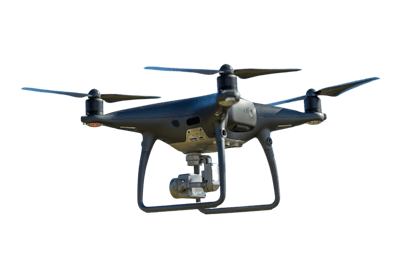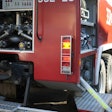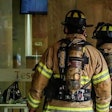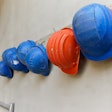
Computerized unmanned aerial systems (UAS) are changing the game for feed and grain facility inspection and repair services. UASes, or drones, can provide a comprehensive examination of the interior of a bin from the outside, reducing labor costs, time and the safety risks associated with entering grain bins.
Cheyenne Wolford, president and CEO of CCS Group, provider of structural assessments, preventive maintenance and emergency grain bin repair services, said the regular inspection of grain silos and bins is as crucial as annual doctor visits for humans.
Why? Because preventive maintenance is a fraction of the cost of a silo rupture or bin collapse, plus maintaining “healthy” structures plays a role in job satisfaction and worker retention. Company morale increases when employees feel safe and reassured by the state of their environment.
Investing in routine bin inspection and maintenance is well worth the cost but is also demanding of a feed or grain facility’s time and other resources. Drone technology helps minimize these burdens.
Looking back and looking up
Traditionally, bin inspections take up to two hours and involve physically lowering a person into a silo. The procedure calls for extensive safety precautions, including fall protection, a rescue plan and the presence of local fire and rescue teams in case of an incident.
“It takes quite a team to drop somebody down safely and to do it the right way,” Wolford said in a Feed & Grain Podcast.
By contrast, drone-powered inspections eliminate the need for human entry altogether and dramatically reduce the time and manpower needed — taking what could be a two-hour process to around 15 minutes.
Austin Carpenter, sales manager for Clear Creek & Associates, said the design and engineering firm frequently uses drones as a lower cost visual inspection option. From a labor standpoint, drones offer many benefits compared to manually collecting the same information.
Carpenter differentiated caged drones as ideal for gaining access to the underside of a grain bin roof without lowering a person in the silo, whereas drones equipped with an infrared camera are suited for identifying high heat signatures around a site.
Not only do drones make the inspection process safer and faster, but they allow for a more comprehensive inspection than a human could achieve while suspended in a silo.
“It’s neat to go back and review that 4k and high-definition video and see things that you didn't see even when you were on site,” Wolford said.
Carpenter highlighted the Skydio Dock and Drone Deploy, technologies and software that allow a drone to be placed on a jobsite or a facility and dispatch a selected flight path, documenting the entire flight through photographs, video or 3D scanning.
“When utilized with software, drones can allow an individual to assign a flight path, document an area then create a 3D photographic model using photogrammetry,” Carpenter said. “This is helpful if you want to see progress on a job site, keep record of an area over time or measure masses like ground piles.”
Securing a safer future
“The safety side of drones is huge,” Wolford said. “No more human entry, and as we know in our industries, our goal is zero human-entry.”
Drones can access areas of a grain bin that might be dangerous for a human inspector to reach. They can fly close to walls, ceilings and other structures to capture data without the physical limitations associated with human inspectors.
“We use them for inspections in areas not accessible by mechanical lifts, like catwalks, towers, inside grain bins and silos, or in circumstances when it is too dangerous for personnel to access -- in bin failures, for example,” Carpenter said.
The latest bin and silo inspection methods eliminate the need for extensive safety risk mitigation and free up emergency services for other critical duties.
Carpenter said the Skydio Dock technology is even being used on a trial basis for emergency response teams in large cities to dispatch drones to 911 calls before officers and first responders can arrive.
Exploring new applications
The industry is optimistic about the future potential of drone advancements.
“Autonomous flying technology is among the most impressive technology I've come across — and it keeps getting better,” Carpenter said. “As the technology improves, battery life will get better, drones will become smaller and onboard cameras will get clearer.”
Drones capable of collecting larger amounts of data, coupled with artificial intelligence (AI), will enable quicker action on valuable insights. As these technologies grow together, “the sky is the limit — at least up to 400 feet, the legal height you can fly a drone,” Carpenter said.
“I could see Skydio Docks at fields for farmers, allowing them to deploy the drone daily for crop inspections,” Carpenter said. "Integration with an AI program could identify a pest or weed and dispatch the drone to a section of the field to apply the appropriate solution for the problem, spot treating the issue."
Purchasing considerations
A thorough bin inspection increasingly relies on a variety of new devices, imaging and measurement technology to safely acquire high-quality photos, videos and data for qualified professional analysis.
If purchasing a drone for your facility, Carpenter recommended users in the feed and grain industry start by defining the need for the drone.
“Will it be used for photography, inspection, data capture?” Carpenter said. “Also, look at what features come for free on the drone and what’s an additional cost. For example, scanning technology could be a software upgrade, ultimately costing more than the purchase price of the drone on an annual basis.”
Leveraging technology to enable the shift away from manual bin inspections highlights how the industry is embracing innovation for a safer feed mill of the future.















